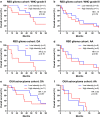Expression and prognostic value of JAM-A in gliomas
- PMID: 28677106
- PMCID: PMC5658466
- DOI: 10.1007/s11060-017-2555-0
Expression and prognostic value of JAM-A in gliomas
Abstract
Gliomas are among the most lethal cancers, being highly resistant to both chemo- and radiotherapy. The expression of junctional adhesion molecule-A (JAM-A) was recently identified on the surface of stem cell-like brain tumor-initiating cells and suggested to function as a unique glioblastoma niche adhesion factor influencing the tumorigenic potential of brain tumor-initiating cells. We have recently identified high JAM-A expression to be associated with poor outcome in glioblastomas, and our aim was to further investigate the expression of JAM-A in gliomas focusing especially on the prognostic value in WHO grade II and III gliomas. JAM-A protein expression was evaluated by immunohistochemistry and advanced quantitative image analysis with continuous estimates of staining intensity. The JAM-A antibody stained tumor cell membranes and cytoplasm to various extent in different glioma subtypes, and the intensity was higher in glioblastomas than low-grade gliomas. We could not detect an association with overall survival in patients with grade II and III tumors. Double-immunofluorescence stainings in glioblastomas revealed co-expression of JAM-A with CD133, SOX2, nestin, and GFAP in tumor cells as well as some co-expression with the microglial/macrophage marker IBA-1. In conclusion, JAM-A expression was higher in glioblastomas compared to low-grade gliomas and co-localized with recognized stem cell markers suggesting an association of JAM-A with glioma aggressiveness. No significant association between JAM-A expression and overall survival was found in grade II and III gliomas. Further research is needed to determine the function and clinical impact of JAM-A in gliomas.
Keywords: Astrocytic brain tumors; Glioma; Junctional adhesion molecule-A; Prognosis; Tumor stem cell.
Conflict of interest statement
All authors declare that they have no conflict of interest.
Figures




Similar articles
-
The prognostic value of clinical factors and cancer stem cell-related markers in gliomas.Dan Med J. 2014 Oct;61(10):B4944. Dan Med J. 2014. PMID: 25283629
-
Nestin and CD133: valuable stem cell-specific markers for determining clinical outcome of glioma patients.J Exp Clin Cancer Res. 2008 Dec 24;27(1):85. doi: 10.1186/1756-9966-27-85. J Exp Clin Cancer Res. 2008. PMID: 19108713 Free PMC article.
-
In vitro neurosphere formation correlates with poor survival in glioma.IUBMB Life. 2019 Feb;71(2):244-253. doi: 10.1002/iub.1964. Epub 2018 Nov 4. IUBMB Life. 2019. PMID: 30393962
-
What is the clinical value of cancer stem cell markers in gliomas?Int J Clin Exp Pathol. 2013;6(3):334-48. Epub 2013 Feb 15. Int J Clin Exp Pathol. 2013. PMID: 23412423 Free PMC article. Review.
-
GSDM family and glioma.Biochim Biophys Acta Rev Cancer. 2025 Apr;1880(2):189283. doi: 10.1016/j.bbcan.2025.189283. Epub 2025 Feb 9. Biochim Biophys Acta Rev Cancer. 2025. PMID: 39929378 Review.
Cited by
-
The Long Non-Coding RNA HOXC-AS3 Promotes Glioma Progression by Sponging miR-216 to Regulate F11R Expression.Front Oncol. 2022 Mar 23;12:845009. doi: 10.3389/fonc.2022.845009. eCollection 2022. Front Oncol. 2022. PMID: 35402226 Free PMC article.
-
Separate and not equal: sex differences in JAM-A tumor suppression in glioblastoma.Neuro Oncol. 2020 Nov 26;22(11):1555-1556. doi: 10.1093/neuonc/noaa218. Neuro Oncol. 2020. PMID: 32960216 Free PMC article. No abstract available.
-
Proteome analysis of urinary biomarkers in a cigarette smoke-induced COPD rat model.Respir Res. 2022 Jun 15;23(1):156. doi: 10.1186/s12931-022-02070-1. Respir Res. 2022. PMID: 35705945 Free PMC article.
-
Tight junction proteins in glial tumors development and progression.Front Cell Neurosci. 2025 Feb 3;19:1541885. doi: 10.3389/fncel.2025.1541885. eCollection 2025. Front Cell Neurosci. 2025. PMID: 39963115 Free PMC article. Review.
-
Junctional Adhesion Molecules in Cancer: A Paradigm for the Diverse Functions of Cell-Cell Interactions in Tumor Progression.Cancer Res. 2020 Nov 15;80(22):4878-4885. doi: 10.1158/0008-5472.CAN-20-1829. Epub 2020 Aug 14. Cancer Res. 2020. PMID: 32816855 Free PMC article. Review.
References
-
- Louis DN, Ohgaki H, Wiestler OD, Cavenee WK, Ellison DW, Figarella-Branger D, Perry A, Reifenberger G, Von Deimling A. WHO classification of tumours of the central nervous system. 4. Lyon: International Agency for Research on Cancer (IARC); 2016. - PubMed
MeSH terms
Substances
Grants and funding
LinkOut - more resources
Full Text Sources
Other Literature Sources
Medical
Research Materials
Miscellaneous

